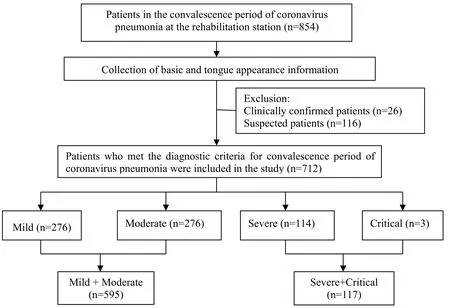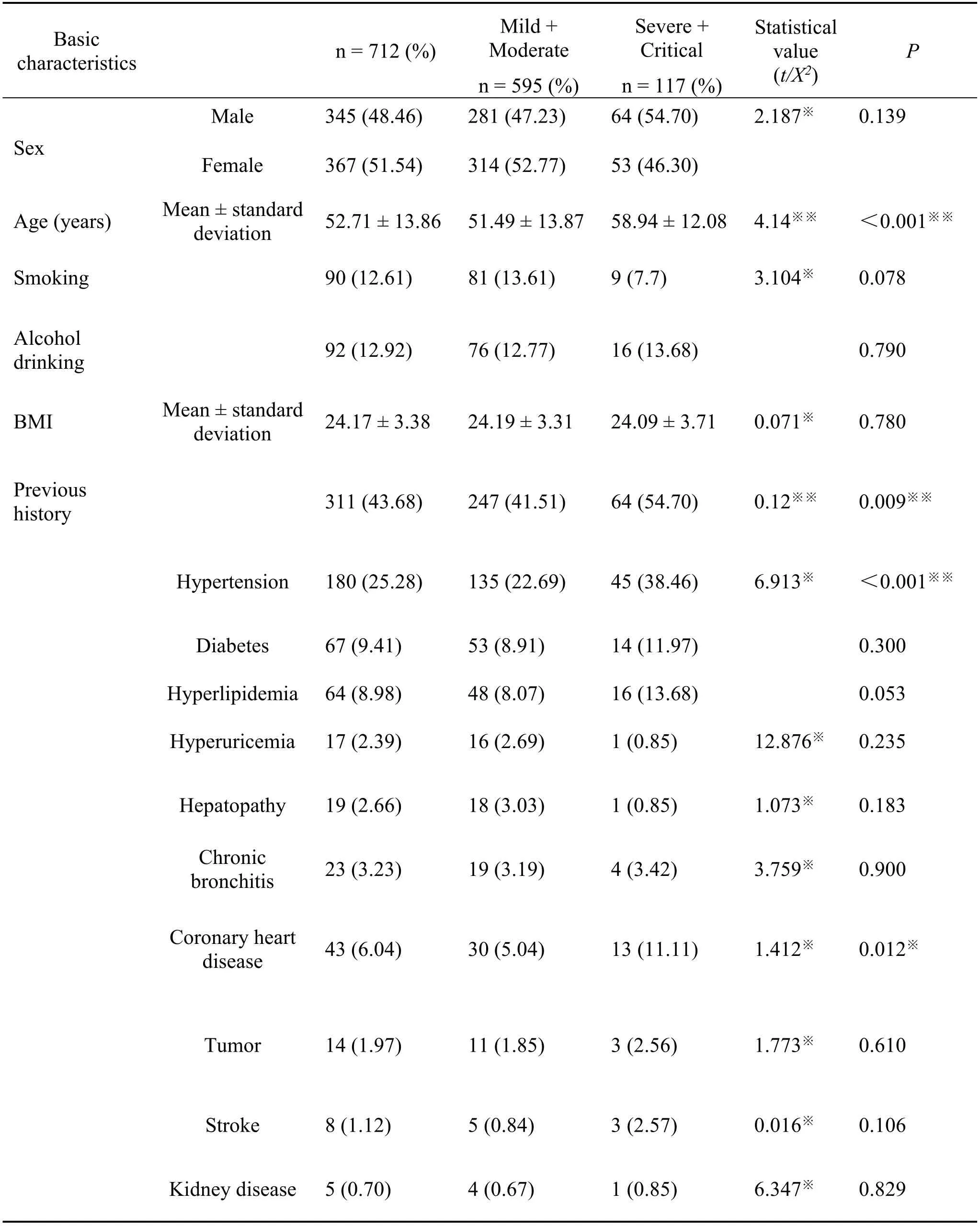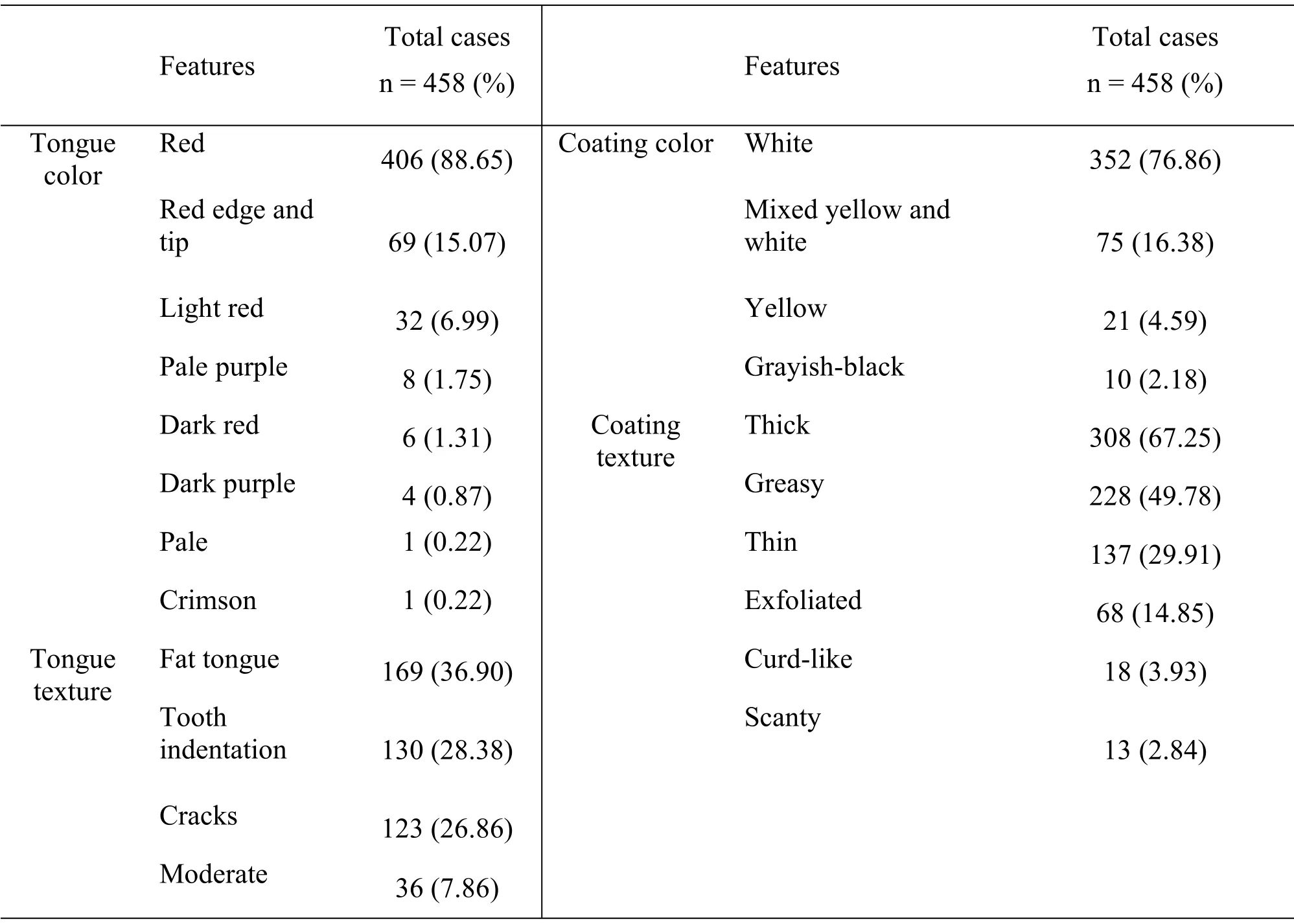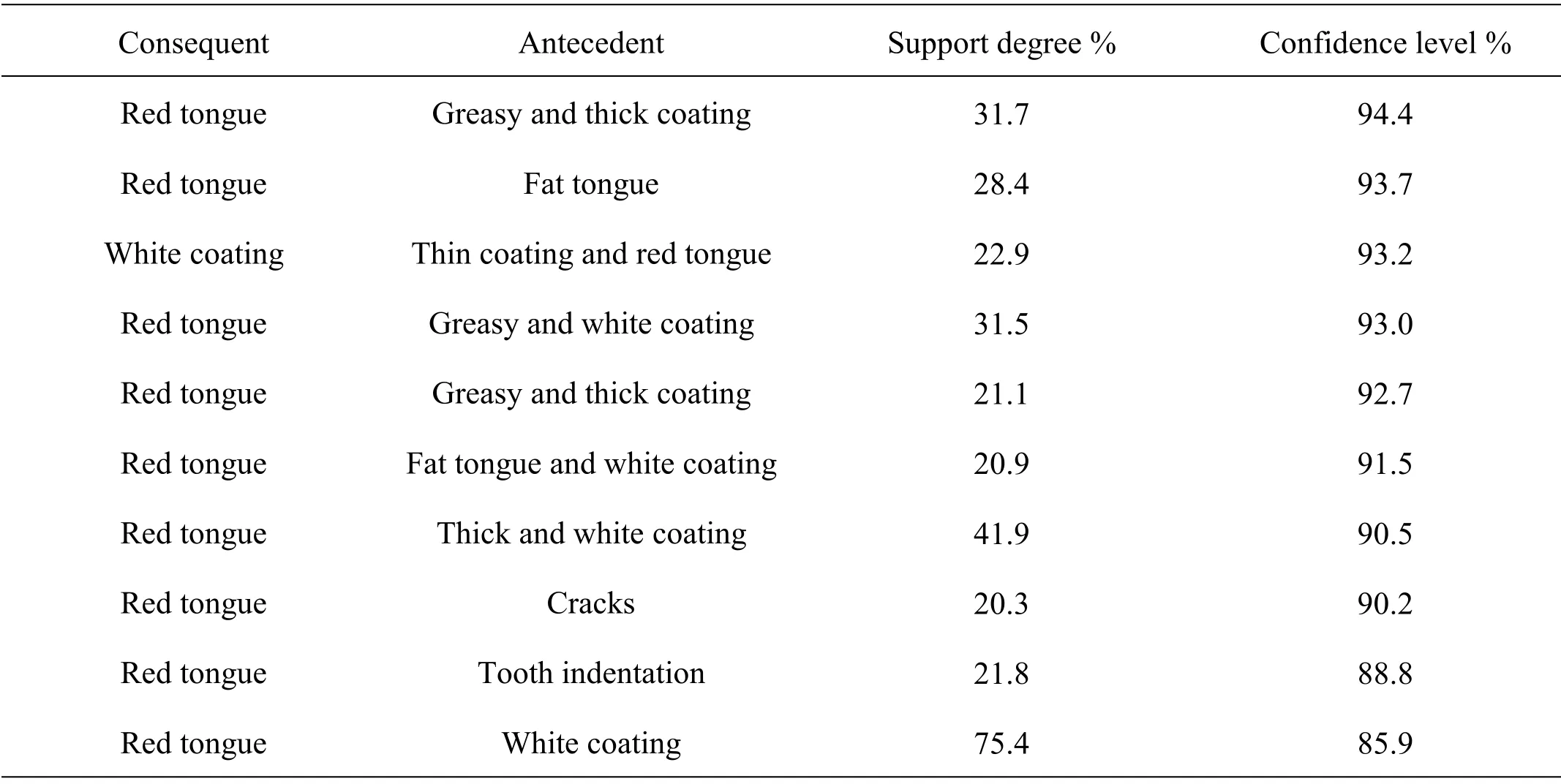Analysis of Clinical Features in Novel Coronavirus Pneumonia Convalescents
2021-09-23MingZhongXiaoQingZhangYiLvJiaKeYiMaXiXuMiaoPengMengRenJunXiuTaoWeiQingWangKaNiOuyangHuiZhuChenXiaLuYaNaZhouXiaoDongLiXiaoLinTong
Ming-Zhong Xiao, Qing Zhang, Yi Lv, Jia Ke, Yi Ma, Xi Xu, Miao Peng, Meng Ren, Jun-Xiu Tao, Wei-Qing Wang, Ka-Ni Ouyang,Hui Zhu,Chen-Xia Lu,Ya-Na Zhou,Xiao-Dong Li*,Xiao-Lin Tong
1Liver Disease branch, Hubei Provincial Hospital of Traditional Chinese Medicine, Affiliated Hospital of Hubei University of Chinese Medicine, Hubei Institute of Traditional Chinese Medicine, Wuhan 430000, China; 2Department of pulmonary medicine, Hubei Hospital of Traditional Chinese Medicine, Affiliated Hospital of Hubei University of Chinese Medicine, Hubei Institute of Traditional Chinese Medicine, Wuhan 430000, China; 3Emergency Department, Hubei Provincial Hospital of Traditional Chinese Medicine,Affiliated Hospital of Hubei University of Chinese Medicine, Hubei Institute of Traditional Chinese Medicine,Wuhan 430000,China;4Clinical College of Traditional Chinese Medicine, Hubei University of Traditional Chinese Medicine, Wuhan 430061, China;5Department of oncology, Hubei Hospital of Traditional Chinese Medicine, Affiliated Hospital of Hubei University of Chinese Medicine, Hubei Institute of Traditional Chinese Medicine, Wuhan 430000, China; 6Departments of Endocrinology, Guang’anmen Hospital of China,Academy of Chinese Medical Sciences,Beijing 100054,China.
Abstract Background: To analyze the clinical features of convalescent individuals with novel coronavirus-infected pneumonia (novel coronavirus pneumonia) at rehabilitation station in Wuhan. Methods: 712 patients in the convalescence period of novel coronavirus pneumonia isolated and observed at the rehabilitation station were investigated by collecting their basic data, clinical syndrome features, and tongue manifestations.The clinical syndrome features were analyzed based on guidelines of Diagnosis and Treatment Plan for Novel Coronavirus-infected Pneumonia (National Health Commission of the People’s Republic of China, 7th Trial Edition). Results: Cough (24.86%), chest tightness and shortness of breath (23.17%), and fatigue (16.57%) were the main symptoms of patients in the convalescence period of novel coronavirus pneumonia.Their tongue appearance was mostly characterized by redness (88.65%), thick coating (67.25%), greasy coating (49.78%) and white coating (76.86%). Conclusion: Compared with the ordinary / mild patients, cough and anorexia symptoms were more common in the severe / critical patients.In convalescent patients, red and fat tongue with thick greasy fur were common.
Key words:Novel coronavirus pneumonia,Convalescence period,Tongue,Clinical feature
Background
The first case of novel coronavirus pneumonia was reported in December 2019 in Wuhan, and since then the number of patients with the condition has increased rapidly with the spread of the pandemic [1].Emergency prevention and control measures were initiated immediately by the concerned authorities,and integrated traditional Chinese and western medicines were actively adopted to treat the affected individuals.As of April 15,2020,78,389 patients were cured of the condition and discharged nationwide.Although there has been an increase in the number of cured and discharged patients, a considerable proportion of these patients have not yet achieved complete recovery,despite negative results of the virus nucleic acid test,thus requiring continuous medical intervention and psychological rehabilitation.An academician, Tong Xiaolin, of the Chinese Academy of Sciences directed the medical care team of Hubei Provincial Hospital of Traditional Chinese Medicine to participate in the traditional Chinese medicine (TCM) comprehensive rehabilitation intervention program for discharged novel coronavirus pneumonia patients in Wuhan since late February 2020, and took the lead in setting up the rehabilitation clinic and ward area.
COVID-19 has strong infectivity, which can be classified into the category of "epidemic disease" in traditional Chinese medicine.It is believed that the cause of epidemic disease is "poison gas", which has strong infectivity.According to the theory of pestilence,it is different from the common cold.It can be transmitted through the mouth and nose in a variety of ways, leading to the occurrence and prevalence of pestilence.This is consistent with the epidemiological characteristics of COVID-19, "the main source of infection is new Coronavirus infection, respiratory droplet and contact transmission is the main transmission route".
The present study collected the clinical data of 712 patients diagnosed as being in the convalescence period of novel coronavirus pneumonia, receiving care at the isolation site of a rehabilitation station in Wuhan,where the Hubei Provincial Hospital of TCM has implemented the TCM rehabilitation program.The basic information, disease history, current TCM syndromes, tongue appearance, among other parameters, of these patients were summarized and analyzed.Based on these parameters,the TCM clinical features of convalescent individuals with novel coronavirus pneumonia can be further understood,providing clinical basis for reference in TCM treatment of such patients.
Materials and methods
Study subjects
The time-phase consecutive cases cluster sampling method was used to select patients in the convalescence period of novel coronavirus pneumonia in Wuhan City from February to March 2020.We selected 6 rehabilitation stations in Wuchang District of Wuhan city from February to March 2020, which were mainly in charge of by Hubei Provincial Hospital of traditional Chinese medicine.
Inclusion criteria: ① Patients with diagnosis of convalescence period of novel coronavirus pneumonia conforming to theDiagnosis and Treatment Plan for Novel Coronavirus-infected Pneumonia(National Health Commission of the People’s Republic of China,7th Trial Edition) [2-7]; ② Patients who were hospitalized for treatment in a hospital or mobile cabin hospital designated for novel coronavirus pneumonia in Wuhan, met the discharge criteria, and entered a designated rehabilitation station in Wuhan for isolation and observation; ③ Patients who consented to participate in our study, and those whose data on the information collection form were complete.
Exclusion criteria: Patients who were unable to cooperate in information collection due to the disease or other systemic illness, severe cognitive impairment,mental abnormality or other reasons[8].
Based on the inclusion and exclusion criteria, a total of 721 patients were included.The general information,demographic information, previous history, physical examination, laboratory examination and other information were collected in the form of questionnaire.
Questionnaire
TheQuestionnaire for Novel Coronavirus Pneumonia Convalescents of Wuhan City, Hubei Provincewas formulated with reference to theDiagnosis and Treatment Plan for Novel Coronavirus-infected Pneumonia(National Health Commission of the People’s Republic of China, 2nd-7th Trial Edition)combining the clinical experience of frontline medical workers and other experts.
The questionnaire mainly included demographic data, previous history, history of smoking and alcohol drinking, clinical symptoms at the initial stage, clinical symptoms in the convalescence period, and information on the diagnosis of TCM Clinical syndrome.The TCM Clinical syndrome differentiation criteria were also established based on the guidelines in theDiagnosis and Treatment Plan for Novel Coronavirus-infected Pneumonia(National Health Commission of the People’s Republic of China, 7th Trial Edition).
Survey Method.Information was collected manually(face-to-face) from novel coronavirus pneumonia convalescents at the designated rehabilitation station on the day they entered the station.The information was collected by the medical team of Hubei Provincial Hospital of TCM.
Content of questionnaire.The survey tool used was theQuestionnaire for Novel coronavirus pneumonia convalescents of Wuhan City, Hubei Province, which included: (1) General data: The general data included:sex, age, disease course, personal habits (smoking and alcohol drinking), past history, symptoms at the initial stage and disease classification, among others.The disease severity was classified as mild, moderate,severe, and critical based on the discharge note and diagnosis certification(issued by the hospital or mobile cabin hospital) carried by the patients.(2) Clinical syndrome: Clinical syndrome was mainly used to assess the severity of the disease,based on a total of 14 items namely fever-sweating,insomnia,among others.
Tongue Appearance Information Acquisition.Patients were positioned under natural light and were asked to protrude their tongues naturally.Huawei P30 mobile phone was used to take high-definition photographs of the tongue of patients.Guo Yi Hui Lian Tongue Imaging Application (developed by Shanghai Daosheng Medical Technology Co, Ltd.China) was used to analyze the images uniformly.The images were processed by the system using AI technologies such as machine learning, deep learning, and neural network algorithms to reduce the influence of light,achieve automatic tongue segmentation, obtain high-definition images, automatically analyze features,and comprehensively assess the appearance of the tongue of patients.
Quality Control.(1) Quality control of the questionnaire: Team members who participated in the survey were the medical staff involved in the first-line clinical treatment of patients with novel coronavirus pneumonia.The investigators underwent uniform training before the survey, and conducted face-to-face interviews to collect data following uniform guidelines and inquiry language.(2)Quality control of the tongue appearance data: A uniform model and shooting settings of the aforementioned mobile phone were adopted, and training on Guo Yi Hui Lian Tongue Imaging APP system was provided.The information was collected and sorted by the same staff member and was submitted to the software for analysis of tongue appearance.(3) Syndrome differentiation criteria: The criteria were established with reference to the diagnosis and treatment sections of theDiagnosis and Treatment Plan for Novel Coronavirus-infected Pneumonia(the 7th trial edition).(4) Data quality control: EpiData3.1 software was adopted for double entry of data, which were subjected to blinded review by specialized data management personnel.

Figure 1 Patient screening flow chart

Table 1 Demographic and medical history of 712 patients in the convalescence period of novel coronavirus pneumonia
Statistical Methods
All data were statistically analyzed using SPSS 21.0 software, and cluster analysis was carried out on clinic symptoms information meeting the requirements.Normal distribution and variance homogeneity analyses were performed on the patients’ data before statistical analyses.Categorical variables were expressed as frequency (constituent ratio).Enumeration data were compared by theΧ2test.Measurement data were expressed as mean ± standard deviation (± s).Intergroup comparison was performed by the independent samples t-test.Rank sum test was used for data not conforming to normal distribution.P <0.05was considered as the value indicating statistically significant difference.Clinical symptoms were imported into the Gephi software(developed by Netbeans) in Comma-Separated Values format to obtain a co-occurrence network through Force Atlas2 algorithm[9]and the layout was obtained using the Cytoscape Apriori algorithm was used to analyze the association rules of the information on tongue appearance.
Results
Basic Features
854 patients were investigated face-to-face, and 854 questionnaires were recovered.After excluding 26 clinically diagnosed cases and 116 suspected cases,712 confirmed patients were included in this study.The screening flow chart is shown in Figure 1.The demographic characteristics and previous medical history of the enrolled patients in the convalescence period of novel coronavirus pneumonia are shown in Table 1.
TCM Clinical Symptoms
Among the 712 convalescents, 388 had significant clinical symptoms, especially cough, chest tightness,shortness of breath and fatigue, as shown in Table 2.Compared with ordinary and mild patients, severe and critical patients had more positive symptoms to be improved after recovery (P= 0.002).The node is drawn with different symptoms as elements.The frequency of symptoms is directly proportional to the size and color depth of the circle (green for ordinary and light patients; red for severe and critical patients).Taking the relationship between different symptom elements as the edge, the thicker the edge, the higher the frequency of simultaneous occurrence of symptom elements,as shown in Figure 2.
Analysis of Tongue Appearance
458 tongue images were collected from 712 patients,as shown in Table 3 and Figure 3.The association rules between tongue color and tongue coating were derived with the settings of support degree >20%, confidence level >80%,and Lift >1.Support degree indicates the percentage of the frequency of tongue image combination in the total number of patients in the recovery period.The higher the confidence degree is,the more likely the tongue image combination appears.The results show that patients in the recovery period often see red fat tongue and thick greasy coating.as shown in Table 4 for the specific association rules.

Table 3 Analysis of tongue appearance in patients in the convalescence period of novel coronavirus pneumonia

Table 4 Tongue appearance association rules
Discussion
The baseline survey of novel coronavirus pneumonia patients showed that the number of patients aged 66 years or older in severe and critical patients was more(P<0.001, who has more kinds of complications)represented by hypertension and coronary heart disease(P<0.001,P= 0.012).It is suggested that more attention should be paid to those people on prevention,diagnosis and treatment during the epidemic period.It is basically consistent with the existing studies, and chronic underlying diseases may be susceptibility factors of COVID-19[10,11].
The results of this study showed that among the 712 convalescents, cough was present in 24.86%individuals (177/712), chest tightness and shortness of breath in 23.17% (165/712), and fatigue in 16.57%individuals(118/712).After entering the convalescence period, the incidence of cough and appetite deficiency in patients with severe and critical diseases is higher than that in patients with mild and ordinary diseases,accompanied by sweating and sleep problems, and patients with fatigue symptoms are more likely to see appetite deficiency, which may influence the progress of recovery [12].According to the clustering results and clinical observation, the patients in convalescence tended to have red tongue and fat tongue with thick and greasy coating, regardless of the severity of the disease.
After discharge, the virology of these patients has turned negative, but the appearance of these symptoms suggest that patients still have lung function decline,low immunity,mental and psychological problems[13].Therefore, it is necessary for convalescent patients to continue to receive treatment and medical observation.The TCM part of suggestions on rehabilitation of novel coronavirus pneumonia during rehabilitation period”and “Rehabilitation treatment for novel coronavirus pneumonia patients with major dysfunction”drafted by Tong Xiaolin can be consulted to improve potency[14,15].To change the treatment on the basis of basic prescriptions in rehabilitation period, combined with tongue changes.For some patients who met the discharge standard, but the lung tablets still indicated that the inflammatory factors and oxygen free radicals in patients who were not fully absorbed had not been cleared complete pathological mechanism can play a comprehensive therapeutic role [16].The active compounds of TCM may act on immune targets to regulate multiple signaling pathways such as TNF for inhibiting "cytokine storm" [17].For example,kaempferol fromAstragalus membranaceuscan inhibit NF-κB, block toll like signaling pathway, reduce the production of reactive oxygen species, and reduce inflammatory response [18].For example,Astragalus kaempferolcan block toll signaling by inhibiting NF-κB in the treatment of invigorating spleen and benefiting lung represented by Dangshen (Codonopsis Radix),Baizhu (Atractylodes Macrocephala Koidz)andFuling (Poria Cocos (Schw.)Wolf).The lung function indexes of FEV,PEF and PV,and the levels of D3 +, CD4 +, CD4 +/CD8 + were significantly improved [19].For some patients who met the discharge standard, but the lung tablets still indicated that the inflammatory factors and oxygen free radicals in patients who were not fully absorbed had not been cleared Complete pathological mechanism can play a comprehensive therapeutic role[20].
Prospective and limitation
The symptoms studied in this study are only the symptoms listed in the questionnaire, so the symptoms with less frequency are not fully discussed.Because most of the cases come from the patients discharged from the isolation point and shelter hospital, they are mostly light and common type, while the number of severe and critical patients is small,and the differences of symptoms in the recovery period between different disease types are not obvious, further exploration with larger sample size is needed.
